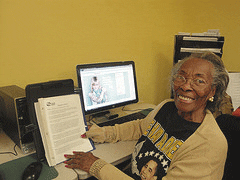
For every aging generation, I imagine feeling “out of the loop” comes with the territory—you are aware that you’ve slowed down, after all. But previous generations of families weren’t as busy or as scattered as we are today, and keeping in touch with one another relies more and more on the Web.
As part of Social Media Week in New York City last month, I attended a screening of the documentary Cyber Seniors. It follows the experiences of participants in a program created by the director’s sisters as a school project, in which residents of two senior living facilities were paired with teenagers to receive one-on-one training on the Internet, and social media in particular. Beyond the practical goals of Cyber Seniors, which were to help bridge, in the words of one of the participants, “the greatest generational divide since the Rock and Roll era,” the program was an interesting social experiment. Both age groups experienced frustration with the other on the pace of progress, but it also became clear that several of the pairs developed friendships that wouldn’t have happened otherwise.
Each of the individual stories made plain the importance of maintaining a feeling of connectedness to the outside world. One man, prior to his training, would set aside one full day each month to make the long trip by public transportation to take care of his banking needs. His partner helped him set up online access, shaving the process down to minutes. Another woman who shared with her teenaged partner how nice it was to be around young people, and the connections—and reconnections—made, with children and grandchildren via Facebook and Skype. Another created a YouTube video series titled “Living With Purpose in Your Retirement Years.”
At Shelterforce, we’re working on an aging issue, and it’s raised questions and assertions about how well the community development field is handling the “age wave.”
A couple of people I’d interviewed for an article mentioned senior housing as being the “safe” kind of affordable housing to build when compared to others, like supportive or family housing. For obvious reasons, I can see why this is—generally, seniors are slow, they’re quiet, don’t take up much space, and don’t drive much. Which means in many ways you can stick them somewhere and forget about them. But what if we didn’t do that, and instead decided to tap into the tremendous asset that is our senior population?
People in the 60+ age group compose a sizable percentage of today’s workforce, and those working in community organizing and development know that seniors have been the backbone of the movement since its beginning. Today’s generation of seniors are healthier and more educated than any before, and in terms of modern American history, have literally seen it all. Programs such as Cyber Seniors are enabling them to remain part of society’s conversations, in the ways and places we are having them.
As more and more seniors hope to age in the communities they helped build, the community development field is integrating them into the fabric of their work. Affordable housing developers are utilizing universal and age-friendly design, but are also thinking creatively about intergenerational housing. Organizations are going beyond bringing seniors together, and developing programs that bring seniors to the rest of the community. One in particular, The Marvin in Connecticut, combines affordable senior housing and an accredited childcare program at which the residents work.
As with other groups the field serves, for example new immigrant populations, looking at seniors’ experiences and skills and taking what may have previously been perceived as a weakness and turning it into an asset takes creativity and intention. But this creativity is growing, and if your organization is working on intergenerational programming, Shelterforce wants you to share it here.
If you are interested in viewing Cyber Seniors or starting a program in your own community, visit them here.
(Photo credit: via Flickr, participant in Neighborhood Centers‘ CLICKS Seniors computer literacy program, CC BY-NC-SA 2.0)






“For obvious reasons, I can see why this is–generally, seniors are slow, they’re quiet, don’t take up much space, and don’t drive much. Which means in many ways you can stick them somewhere and forget about them. But what if we didn’t do that, and instead decided to tap into the tremendous asset that is our senior population?”
Your intentions are good, but it seems to me that you only know about “seniors” and “senior housing” from the the outside.
I suggest that you forget everything you learned and sit in the lobby for a while after the management office is closed.